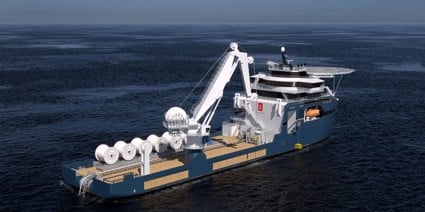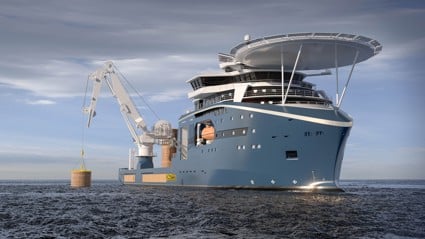High mooring rope capacities are also required, excluding many vessels currently in the market. A specialised mooring installation vessel, which typically features an offshore crane, significant engine power, bollard pull, and comprehensive winch and deck equipment package for mooring work, is the ultimate solution for large mooring installations. However, the building costs for such a vessel are high compared to a mooring capable OSCV.
Finally, for ad hoc OSCV mooring operations, such as hang-off frames, lay-towers and chain handled by crane, these operations are not standardised and often carry operational risks and inefficiencies.
Key components
A large deck space is required for anchors, equipment and reels. An offshore crane is essential for installing anchors, connecting mooring lines and lifting reels. A stern roller is necessary for the mooring line to pass over. In addition, tow pins and shark jaws control and secure the mooring line.
There is a winch with chain wheels and drum for handling chain and wire, lowering or recovering mooring lines, and holding chain weight. The winch is either low pressure hydraulic or permanent magnet motor electric.
Different deck layouts can ensure substantial fibre rope capacity. While OSCVs may lack sufficient bollard pull for traditional drag embedment anchors, they are well-suited for installing suction piles. Planning marine operations can address the need to pull the inverse catenary of the pile chain, which can be managed by anchor handling vessels during the hook-up phase.
These proposed adjustments to construction vessel newbuilds will position them to take on a larger portion of mooring line installations.
Runar adds: “These vessels have synergies with other field development activities, so the message to owners who are planning newbuilds is simple – why not make your construction vessels mooring installation capable?”
With this solution, OSCVs become a more attractive and efficient option for a broader range of mooring operations, ensuring reliable performance and safety in harsh offshore environments.






